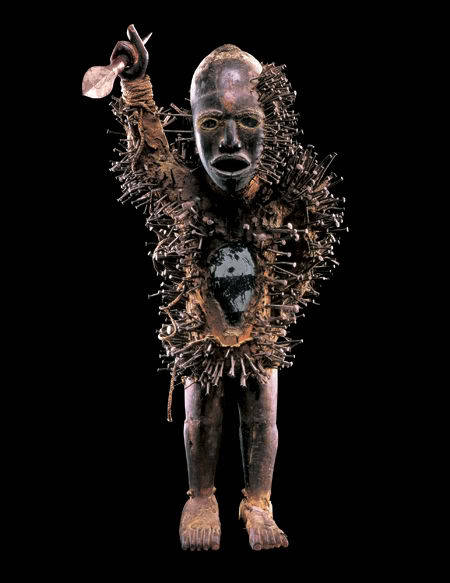Initial Reaction:
At first glance of the piece "Tattooed Marquesan Warrior," several stylistic elements come forward in its description. When describing, it is evident that the use of geometric shapes and lines were important in not depicting the contour of the human anatomy, but rather its inner form, the anatomy the skin, an idea important in early Chinese art. Looking further, Negative space and heavy contrast between the contour of the body and the background suggest a heightened focus on the central character. Minimal horizontal lines at the base hint at a background space, and a simple one color foreground place the subject on a plane directly in front of the viewer. Certain elements of the form and shape, i.e. the shading of the body according to underlying muscle structure demonstrates a firm understanding of the human anatomy and the play of light vs. shadows on it. Also, the muted blues, rusty reds, faded yellows and greens would suggest a focus on the geometric designs within the contour of the body. In retrospect, first glance would lead me to believe it a mesoamerican or southwestern asian(polynesian) islands piece, but the depiction of the facial structure and hair would lead me to believe it was a representation of one of the aforementioned cultures by a European, possibly Spanish artist.
 |
Fig. 1 "Tattooed Marquesan Warrior." Engraving of Noukahiwa
in N. Dally's Customs and Costumes of the Peoples of the World,
Turin, 1845. Musée des Arts Décoratifs, Paris.
|
After Research:
After researching the "Tattooed Marquesan Warrior," the work's motives, history, and symbology provided much more clarity to my initial reaction. This engraving is found in N. Dally's Customs and Costumes of the Peoples of the World, and represents Noukahiwa, a warrior from the Marquesas in what was French Polynesia (O'Riley). But what was more important than the figure himself was the art that resided in his skin. With a highly spiritual emphasis on art, tattooing was considered one of the most important art forms in their culture. Tattooing was a way of preserving one's mana, or sacred powers passed on by their ancestors. For the Marquesa, Tatau(tattoo), was an art form highly revered by the people and the Tatau artists, often called Tuhuka or Tuhuna, meaning master, were often held in high regard with other artists and priests(O'Riley). Moreover, these tattoos carried significant importance to one's mana. These marking were etched in one's body, and were direct links to one's ancestors, past, and mana. They empowered the wearer, beautified the body, and made the wearer a living work of art, and a direct link to their ancestors(O'Riley). In addition, the Tuhuka worked with the form of the body itself, etching straight lines, geometric patterns, and curves that followed the body. In essence, the tataus of the Marquesan peoples weren't purely superficial designs; they were lines, intricate patterns, and master plans, creating paths that could be traveled, connecting these people with their past. Often taking years to complete, it used the human body to create a spirit or energy that lifted the wearer into a heightened sense of spirituality, a living work of art. For the Marquesa, the human body was merely a conduit for art, one of the highest spiritual elements they worked with. This piece not only serves its purpose as a window into what was an alien culture to the French, but as a window into their spirituality and beliefs, a window to their ancestors.
References:
O'Riley, Michael Kampen. "The Pacific." In Art Beyond the West, 217-219. 2nd ed.
Upper Saddle River, NJ: Pearson Prentice Hall, 2006.
Fig. 1. N. Dally, Tattooed Marquesan Warrior. 1845, Engraving. Musée des Arts
Décoratifs, Paris. From Customs and Costumes of the Peoples of the World,
Turin. 1845. In Art Beyond the West, 218.





